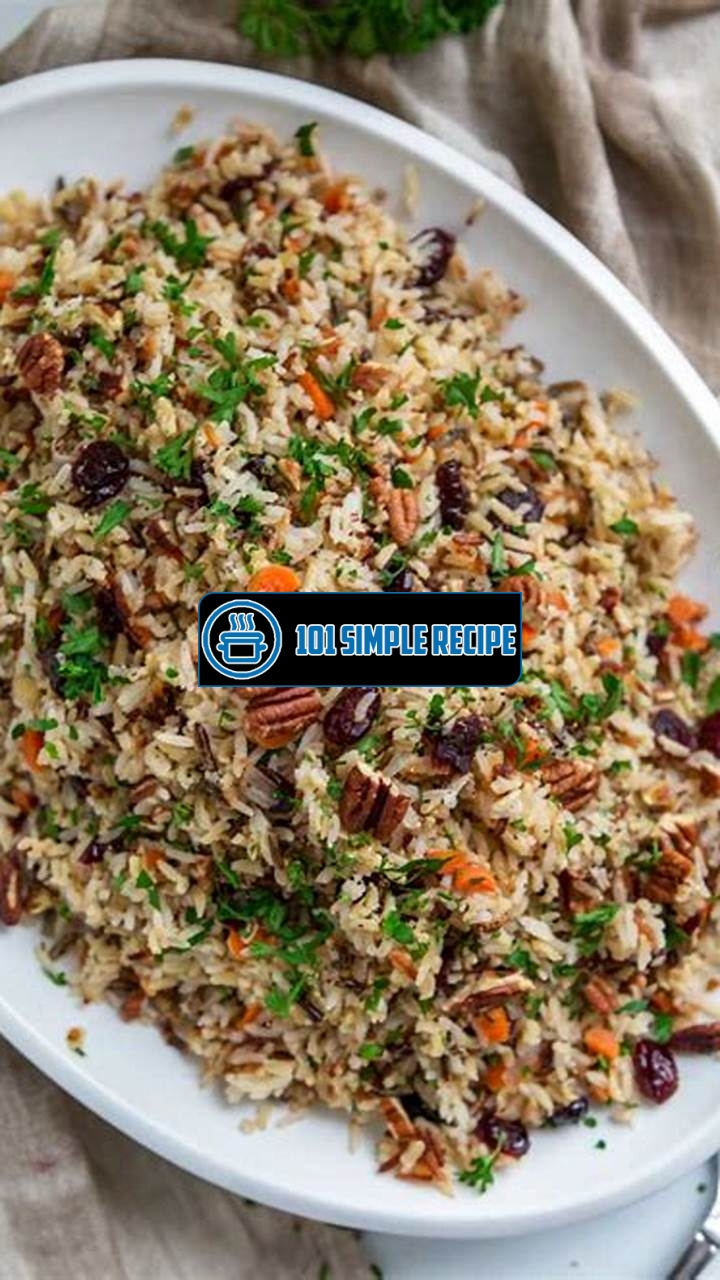Looking for a delicious and flavorful meal that will satisfy your taste buds? Look no further than this mouthwatering Wild Rice Pilaf recipe. Made with a combination of aromatic wild rice, fresh vegetables, and flavorful herbs and spices, this dish is sure to impress your family and friends. Whether you’re a vegetarian or simply looking for a tasty side dish, this recipe is a perfect choice. Get ready to indulge in a symphony of flavors and textures with every bite!

The History of Wild Rice Pilaf
Discover the origins of wild rice pilaf and its cultural significance.
Native American Origins
Wild rice pilaf has a rich history that traces back to Native American cultures. Native Americans have been cultivating and consuming wild rice for centuries, considering it a staple food. The Ojibwe and Sioux tribes were particularly known for their expertise in growing and harvesting wild rice.
Wild rice, scientifically known as Zizania palustris, is native to North America and primarily found in the Great Lakes region. Native Americans would paddle out in canoes to harvest the long, slender grains from the rice beds. They would hold the stalks over the canoe and gently knock the grains with a wooden stick, allowing them to fall into the vessel. The rice was then dried and stored for future use.
Wild rice played a significant role in Native American ceremonies and feasts. It symbolized sustenance, fertility, and interconnectedness with nature. It was often shared with neighboring tribes as a sign of goodwill and unity.
Incorporation into Western Cuisine
In the 18th century, European traders and settlers encountered wild rice pilaf during their interactions with Native American communities. They were fascinated by its unique taste and nutritional benefits. Wild rice soon made its way into Western cuisine and gained popularity as a versatile ingredient.
French and British settlers in North America quickly adopted wild rice pilaf into their cooking, adding their own twist to the traditional Native American preparation methods. The dish became a staple on colonial tables, with variations incorporating ingredients like herbs, vegetables, and meats.
As time went on, wild rice pilaf spread beyond North America and gained recognition in international gastronomy. Chefs and home cooks around the world started experimenting with the exotic ingredient, showcasing its delicate yet nutty flavor in various culinary creations.
Variations Across Different Cultures
While wild rice pilaf has its roots in Native American culture, it has been adapted and incorporated into cuisines across different cultures. Each culture has put its own spin on the dish, resulting in unique and diverse recipes.
For example, in Asian cuisine, wild rice pilaf is often combined with flavorful spices, exotic vegetables, and fragrant herbs. The dish takes on an aromatic and vibrant character, complementing the bold flavors commonly found in Asian cooking.
In Mediterranean cuisine, wild rice pilaf is often paired with fresh seafood, olives, and citrus flavors, bringing a refreshing and tangy element to the dish. The combination of the nutty wild rice with the bright Mediterranean ingredients creates a delightful mix of textures and tastes.
Across Africa, wild rice pilaf is often prepared with traditional spices and a variety of local ingredients such as okra, tomatoes, and peppers. These vibrant and bold flavors showcase the diversity of the continent’s culinary traditions.
Wild rice pilaf has truly become a global dish, loved and appreciated by people from all walks of life. Its ability to adapt to different cultures and cuisines is a testament to its lasting appeal and versatility.
In conclusion, the history of wild rice pilaf reveals its deep cultural significance and its journey from Native American staple to a beloved dish in varied cuisines. It is a testament to the rich culinary heritage and the interconnectedness of cultures around the world.
Health Benefits of Wild Rice Pilaf
When it comes to nutritious and delicious meals, wild rice pilaf is a top contender. This scrumptious dish is not only pleasing to the palate but also packed with health benefits that can positively impact your well-being. Include wild rice pilaf in your diet regularly to enjoy its numerous advantages. Let’s explore the nutritional advantages of this flavorful dish:
High in Fiber and Protein
One notable benefit of wild rice pilaf is its high fiber and protein content. Both fiber and protein are essential nutrients that play crucial roles in maintaining a healthy body.
Fiber is crucial for proper digestion and can help prevent constipation. It also aids in weight management by promoting feelings of fullness, reducing overeating, and supporting a healthy metabolism.
Protein is the building block of muscles, skin, and other body tissues. It plays a vital role in repairing and replenishing cells, as well as supporting the immune system.
By including wild rice pilaf in your meals, you’re providing your body with a good dose of both fiber and protein, helping you stay satisfied and promoting overall well-being.
Packed with Essential Vitamins and Minerals
Wild rice pilaf is not just a flavorful dish; it is also a powerhouse of essential vitamins and minerals that your body needs to function optimally.
This delicious dish contains vitamin B6, which plays a vital role in brain development and function. It is also rich in magnesium, which helps maintain normal muscle and nerve function, as well as supporting a healthy immune system.
Additionally, wild rice pilaf provides a good amount of iron, which is crucial for the production of red blood cells and oxygen transport throughout the body. It is also a good source of zinc, which supports the immune system and helps with wound healing.
Incorporating wild rice pilaf into your diet ensures that you’re getting a variety of essential vitamins and minerals, helping you maintain optimal health and well-being.
Rich in Antioxidants
Antioxidants are substances that help protect the body from harmful free radicals, which can damage cells and contribute to various health problems. Wild rice pilaf is a rich source of antioxidants, making it an excellent addition to your diet.
This flavorful dish contains vitamin E, a potent antioxidant that protects cells from oxidative stress. It also contains phytonutrients, which are plant compounds that have antioxidant properties.
By enjoying wild rice pilaf regularly, you’re nourishing your body with a wide range of antioxidants, promoting cellular health and reducing the risk of chronic diseases.
In conclusion, wild rice pilaf is not only a delightful dish but also a nutritional powerhouse. Its high fiber and protein content, abundance of essential vitamins and minerals, and richness in antioxidants make it an excellent choice for a flavorful and healthful meal. Include wild rice pilaf in your diet to reap its numerous benefits and savor every nutritious bite. Bon appétit! ️
Choosing the Right Wild Rice for Pilaf
When it comes to preparing a delicious wild rice pilaf, one of the most important steps is choosing the right type of wild rice to use. The type of wild rice you select will greatly affect the overall taste and texture of your pilaf dish. In this section, we will explore the different varieties of wild rice and provide helpful tips to ensure you pick the perfect one for your recipe.
Understanding the Different Varieties of Wild Rice
Wild rice comes in various types, each with its own unique qualities. It’s essential to understand the differences between these varieties to make an informed decision:
1. Long Grain – This type of wild rice has a slender, elongated shape. It is known for its chewy texture and slightly nutty flavor. Long grain wild rice takes longer to cook compared to other varieties, making it ideal for those who prefer a heartier pilaf.
2. Medium Grain – Medium grain wild rice is shorter in length and has a plumper appearance. It tends to be softer and more tender than long grain wild rice. If you prefer a pilaf with a slightly softer texture, this variety might be the right choice for you.
3. Black Wild Rice – Black wild rice has a dark, almost black color and is known for its earthy and nutty flavor. It has a slightly chewy texture. Incorporating black wild rice into your pilaf recipe can add visual appeal and an extra layer of taste.
4. Red Wild Rice – Red wild rice, as the name suggests, has a reddish-brown hue. It has a slightly sweeter taste compared to other varieties and pairs well with a variety of ingredients. Adding red wild rice to your pilaf can bring a rich, vibrant color to the dish.
Considering Texture and Cooking Time
When selecting wild rice for your pilaf, it’s important to consider both the desired texture of your dish and the time you have available for cooking:
1. Texture: If you prefer a chewier and heartier pilaf, choose long grain wild rice. For a softer and more delicate texture, opt for medium grain wild rice.
2. Cooking Time: Keep in mind that the cooking time may vary depending on the type of wild rice you choose. Long grain wild rice typically takes longer to cook compared to other varieties. Consider the time you have available and plan accordingly.
Quality Indicators for Fresh Wild Rice
When purchasing wild rice for your pilaf recipe, there are a few key indicators to look out for to ensure freshness and quality:
- Color: Fresh wild rice should have a uniform color and not contain any discolored or dull grains.
- Aroma: Give the wild rice a sniff to ensure it has a pleasant, nutty aroma. Avoid any rice with a musty or off-putting smell.
- Texture: The grains should feel firm and intact. Avoid rice with broken or damaged grains.
- Packaging: Purchase wild rice from reliable sources and check the packaging for any signs of damage or tampering.
By considering these indicators, you can ensure that the wild rice you choose for your pilaf recipe is of the highest quality.
Now that you have a better understanding of how to select the best wild rice for your pilaf, you can confidently embark on your culinary journey. Remember to experiment with different varieties to find the one that suits your taste preferences and desired texture. Enjoy creating your flavorful and delicious wild rice pilaf!
Key Ingredients for a Flavorful Wild Rice Pilaf
When it comes to creating a delicious wild rice pilaf, there are several key ingredients that you simply can’t do without. These components work together to bring out the flavors and textures that make this dish so satisfying. From vegetables and aromatics to herbs and spices, and even nuts and dried fruits, each ingredient plays a vital role in creating a mouthwatering wild rice pilaf.
Vegetables and Aromatics
The foundation of any good wild rice pilaf starts with a medley of vegetables and aromatics. These ingredients provide a savory base that infuses the rice with flavor. Common vegetables used in a wild rice pilaf include onions, celery, carrots, and bell peppers. To enhance the taste, aromatics such as garlic, shallots, and fresh herbs like thyme and rosemary can be added. These vegetables and aromatics not only add depth to the dish but also provide essential nutrients.
Enhancing Flavors with Herbs and Spices
To elevate the taste profile of your wild rice pilaf, herbs and spices are a must-have. The right combination can add a burst of flavors and aromas that takes the dish to new heights. Classic flavor-enhancers for a wild rice pilaf include bay leaves, parsley, and black pepper. For some added warmth and complexity, you can experiment with spices like cumin, coriander, and paprika. Don’t forget to season with salt to bring out the natural flavors of the rice and other ingredients. ️
Adding Variety with Nuts and Dried Fruits
If you want to add some extra texture and an element of surprise to your wild rice pilaf, nuts and dried fruits are your secret weapons. Nuts like sliced almonds, toasted pecans, or even pine nuts can provide a delightful crunch and nuttiness to every bite. Dried fruits such as cranberries, raisins, or apricots bring a touch of sweetness and chewiness. These additions not only enhance the visual appeal of the dish but also add a burst of flavors that complement the savory nature of the pilaf.
By combining these key ingredients, you can create a wild rice pilaf that is bursting with flavor and complexity. The vegetables and aromatics provide a solid base, while the herbs and spices elevate the taste profile. Finally, the nuts and dried fruits add variety and texture to each forkful. So why not gather these ingredients and embark on a culinary adventure by making your own wild rice pilaf today?
Mastering the Art of Cooking Wild Rice Pilaf
When it comes to creating a delicious and flavorful meal, mastering the art of cooking wild rice pilaf is a must. This versatile dish can be served as a side or as a main course, and its nutty and earthy flavors make it a favorite among many. In this article, we will provide you with step-by-step instructions for preparing a perfect wild rice pilaf every time.
Preparation and Rinsing of Wild Rice
The first step in creating a delectable wild rice pilaf is to properly prepare and rinse the wild rice. To do this, start by measuring the desired amount of rice and place it in a fine-mesh strainer. Rinse the rice under cold water, gently rubbing it with your fingers to remove any debris or excess starch. Repeat this process until the water runs clear.
Once the wild rice is rinsed, transfer it to a medium-sized saucepan. Add enough water to fully submerge the rice and bring it to a boil over medium heat. Reduce the heat to low, cover the saucepan, and let the rice simmer for about 45 minutes, or until it is tender. Once cooked, drain any excess liquid and set the rice aside.
Sautéing and Sourcing Additional Ingredients
Next, it’s time to add some extra flavor to your wild rice pilaf by sautéing and sourcing additional ingredients. In a large skillet, heat some olive oil or butter over medium heat. Add diced onions, minced garlic, and your choice of vegetables, such as carrots, bell peppers, or mushrooms. Sauté the ingredients until they become tender and aromatic.
While the vegetables are cooking, you can also prepare any additional ingredients you want to include in your rice pilaf. This could include proteins like diced chicken, shrimp, or tofu, or other flavor-enhancing ingredients like dried herbs, spices, or nuts. Chop or measure these ingredients beforehand, so they are ready to be added to the skillet once the vegetables are cooked.
Simmering and Steaming Techniques
Now it’s time to bring all the flavors together by simmering and steaming the rice and ingredients. Add the cooked wild rice to the skillet with the sautéed vegetables and additional ingredients. Stir everything together until well combined and let it simmer for a few minutes to allow the flavors to meld.
For added moisture and to ensure a fluffy texture, you can also steam the rice pilaf. To do this, add a small amount of vegetable or chicken broth to the skillet, covering it with a lid. Let the mixture steam over low heat for about 5-10 minutes, or until the liquid is absorbed and the rice is fully cooked.
Once the rice pilaf is ready, remove it from the heat and let it rest for a few minutes to allow the flavors to fully develop. Serve the pilaf as a standalone dish or as a side to complement your favorite protein or vegetable dish. Enjoy the delightful combination of flavors and textures that wild rice pilaf offers!
Frequently Asked Questions
Here are some frequently asked questions about our wild rice pilaf recipe:
| No. | Questions | Answers |
|---|---|---|
| 1. | How long does it take to cook wild rice pilaf? | The total cook time for this wild rice pilaf recipe is approximately 45 minutes. |
| 2. | Can I use vegetable broth instead of chicken broth? | Yes, you can easily substitute vegetable broth for the chicken broth in this recipe. |
| 3. | Can I add other vegetables to the wild rice pilaf? | Absolutely! Feel free to customize this recipe with your favorite vegetables such as carrots or peas. |
| 4. | Is wild rice pilaf gluten-free? | Yes, wild rice is inherently gluten-free, making this pilaf recipe suitable for those with gluten intolerance or sensitivity. |
| 5. | Can I make this recipe in advance? | Certainly! This wild rice pilaf can be made ahead of time and reheated when needed. Just make sure to store it properly in an airtight container in the refrigerator. |
| 6. | What can I serve with wild rice pilaf? | Wild rice pilaf is a versatile side dish that pairs well with various proteins such as chicken, beef, or fish. It’s also great as a standalone vegetarian dish. |
Thank You for Reading!
We hope you enjoyed learning about our delicious wild rice pilaf recipe. Don’t forget to bookmark our website and visit us again later for more mouthwatering recipes. Whether you’re an experienced cook or just starting out, we have something for everyone. Stay tuned for new recipes and culinary adventures. Happy cooking!
Jump to Recipe
Wild Rice Pilaf Recipe

Learn how to make a flavorful wild rice pilaf with this easy recipe. Perfect as a side dish or standalone vegetarian meal.
- 1 cup wild rice
- 2 cups vegetable broth
- 1/2 cup diced onion
- 1/2 cup diced celery
- 1/2 cup diced bell pepper
- 2 cloves garlic (minced)
- 2 tablespoons olive oil
- 1/2 teaspoon dried thyme
- Salt and pepper to taste
- In a saucepan, bring the vegetable broth to a boil. Add the wild rice and reduce heat to low. Cover and simmer for 45 minutes or until the rice is tender and the liquid is absorbed.
- In a separate skillet, heat olive oil over medium heat. Add the onion, celery, bell pepper, and garlic. Cook until the vegetables are softened and lightly browned, about 5-7 minutes.
- Transfer the cooked wild rice to the skillet with the sautéed vegetables. Add dried thyme, salt, and pepper. Stir well to combine and cook for an additional 2-3 minutes to allow the flavors to meld together.
- Remove from heat and serve the wild rice pilaf hot. It pairs well with chicken, beef, or fish, or can be enjoyed as a standalone vegetarian dish.






